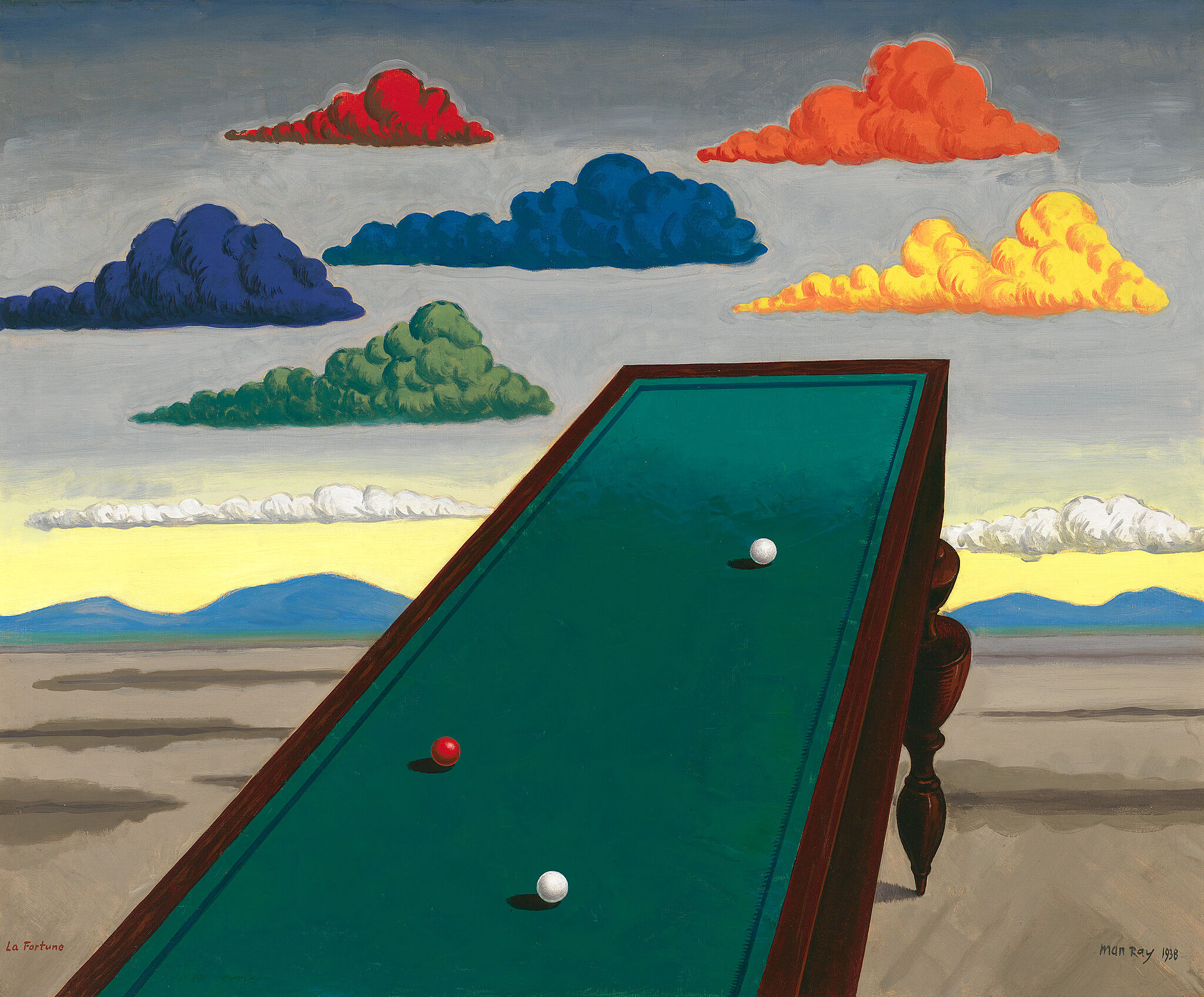Man Ray
1890–1976
Man Ray was the only American artist to play a leading role in the Dada and Surrealist movements, spending much of his career in Europe. The son of Russian-Jewish immigrants, he was born Emmanuel Radnitzky and adopted the pseudonym Man Ray at the outset of his career. After collaborating in New York with French Dadaists Marcel Duchamp and Francis Picabia, Man Ray moved to Paris in 1921. During the following decade, he focused on photography, using the medium to portray members of his avant- garde Parisian milieu as well as to transform everyday objects into strange and disconcerting Surrealist compositions, as in this untitled photograph of a mannequin’s hand.
He shifted to painting in the 1930s, creating Surrealist canvases such as La Fortune, which he produced shortly before fleeing Nazi-occupied Paris for Los Angeles. The composition is dominated by an oversized pool table, which looms over an uninhabited landscape and a sky filled with rainbow-hued clouds. Man Ray described the painting in relation to a string of personal associations: “I distorted the perspective of that table on purpose, I wanted it to look as big as a lawn. I could have had two people playing tennis on it.” The pool table also alludes to the Surrealist fascination with games and chance as creative springboards, while the spectrum of clouds evokes a painter’s palette, suggesting an allegory of artistic creation. The table’s lack of pockets indicates that the game, like all Surrealist propositions, will not follow rational rules or logic—but the painting’s title, meaning wealth or luck, seems to augur rewarding possibilities.
Introduction
Man Ray (born Emmanuel Radnitzky; August 27, 1890 – November 18, 1976) was an American visual artist who spent most of his career in Paris. He was a significant contributor to the Dada and Surrealist movements, although his ties to each were informal. He produced major works in a variety of media but considered himself a painter above all.
He was a photography innovator as well as a fashion and portrait photographer, and is noted for his work with photograms, which he called "rayographs" in reference to himself.
Wikidata identifier
Q46139
Information from Wikipedia, made available under the Creative Commons Attribution-ShareAlike License . Accessed November 9, 2025.
Introduction
The influential and prolific American photographer and painter adopted the pseudonym Man Ray around 1909. He was a prominent force of Dada and Surrealism, and the only American to play a significant role in the development of those movements. His visits to Alfred Stieglitz's gallery, 291 introduced him to a wide variety of European contemporary artists, such as Picasso, Rodin, and Braque. Like many other artists of his time, he was also greatly influenced by the avant-garde Armory show in New York City in 1913. His paintings from this period show his fascination with the flatness of Modernism and his interest in the patterns of shapes rather than a realistic rendering of subject matter. During his trip to Paris in 1921, Man Ray began to experiment with photography, and may have been introduced to the photogram by Tristan Tzara. He adopted the method and called his works "rayographs," photographic images composed of ordinary objects placed on photo sensitive paper exposed to light. Together with his muse Lee Miller, he developed the solarization process which he used in his fashion and nude photography. With the onset of World War II, he lived in California and concentrated on painting and making objects. He returned to Paris in 1951, where he remained until his death. Man Ray was one of the first artists to make photographs seen as important works of art, equal to that of painting and sculpture.
Country of birth
United States
Roles
Artist, assemblage artist, cinematographer, engraver, landscapist, painter, photographer, sculptor
ULAN identifier
500015030
Names
Man Ray, Man Rei, Emmanuel Radenski, Emmanuel Radensky, Emmanuel Radnitsky, Emmanuel Radnitzky, Ray [rejected], Emmanuel Rudnitsky, Emmanuel Rudnitzky, Emmanuel Rudnizky, マン·レイ
Information from the Getty Research Institute's Union List of Artist Names ® (ULAN), made available under the ODC Attribution License. Accessed November 9, 2025.













